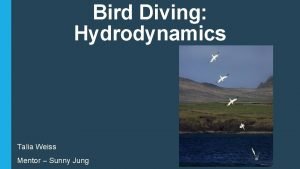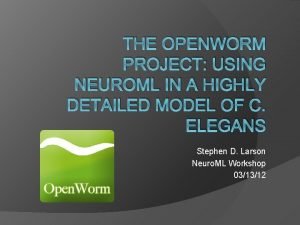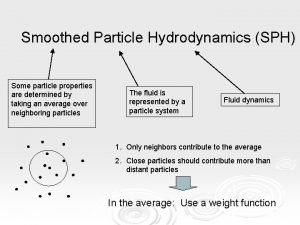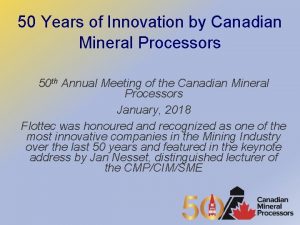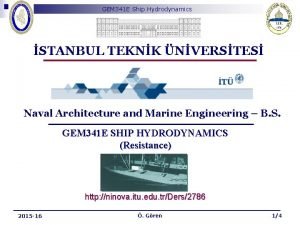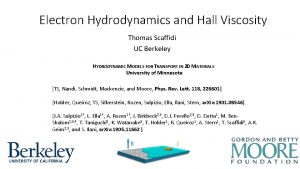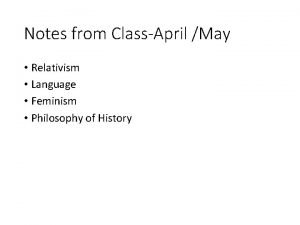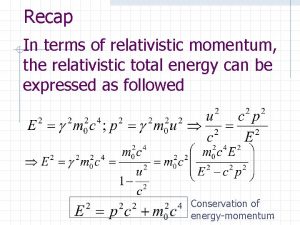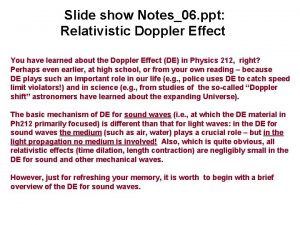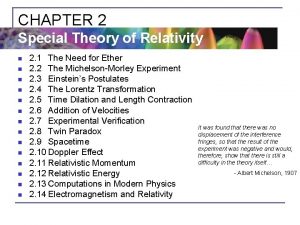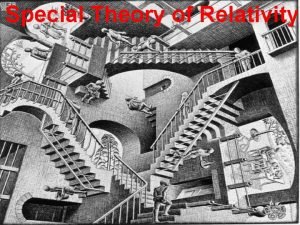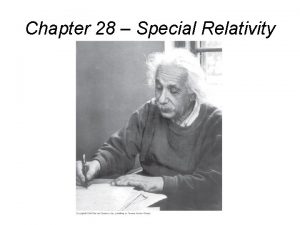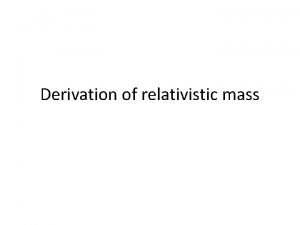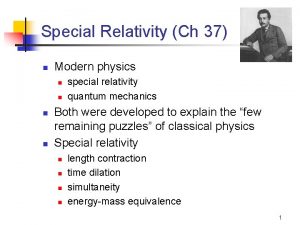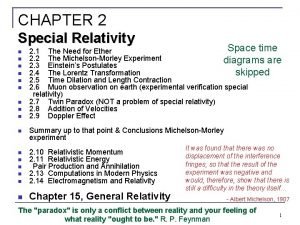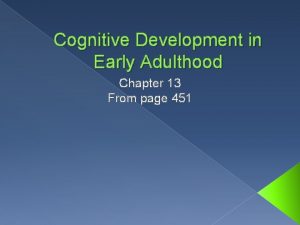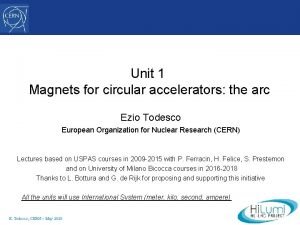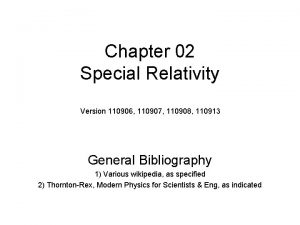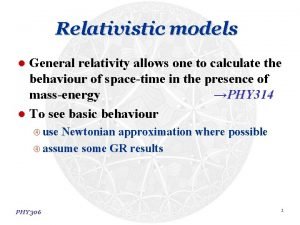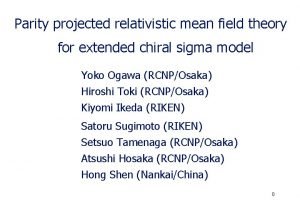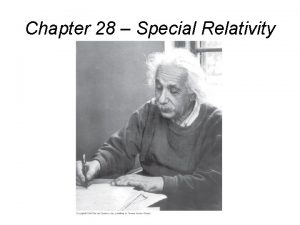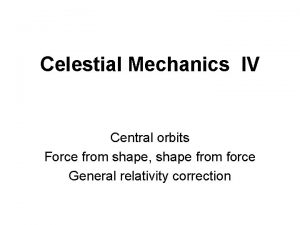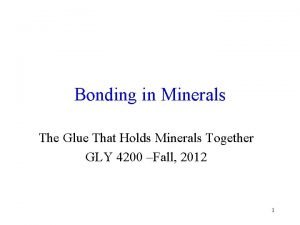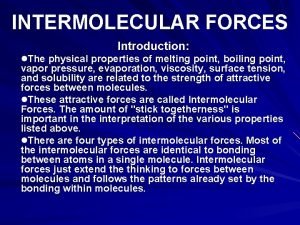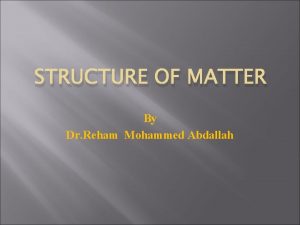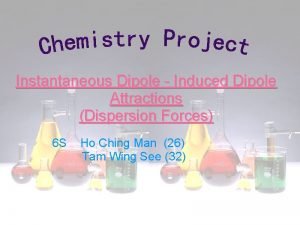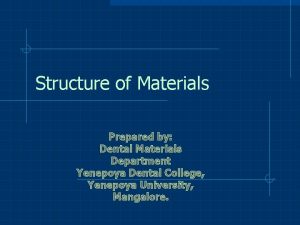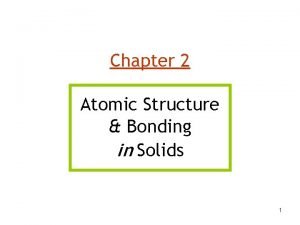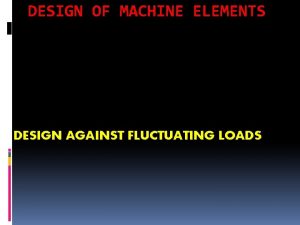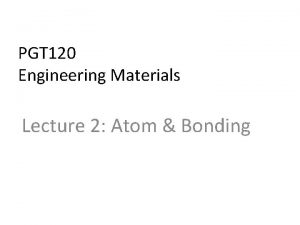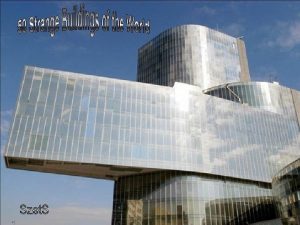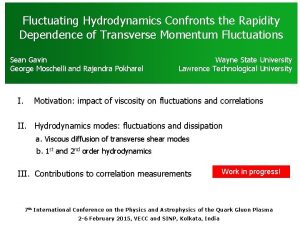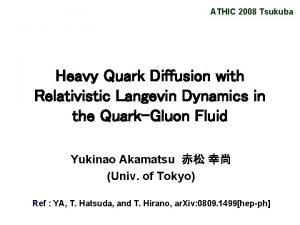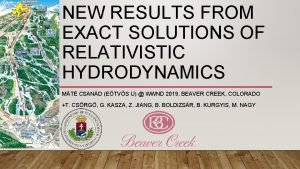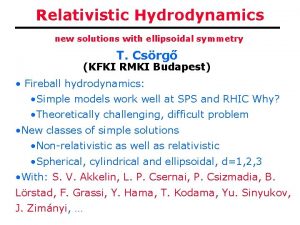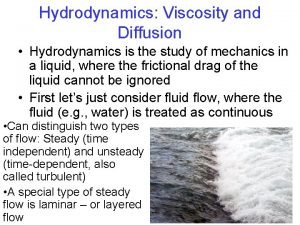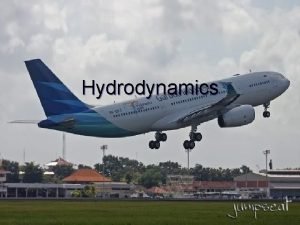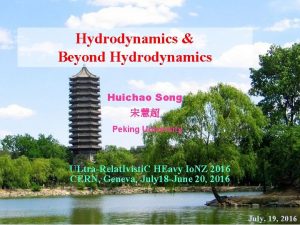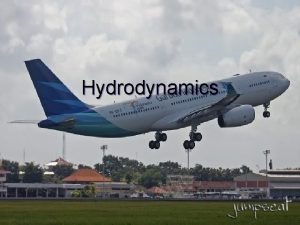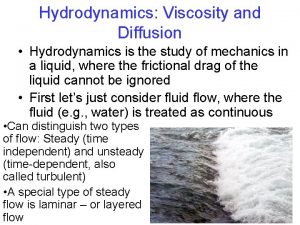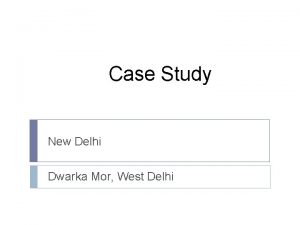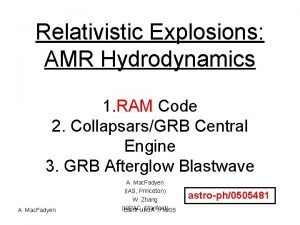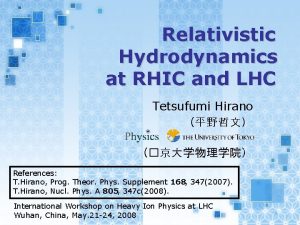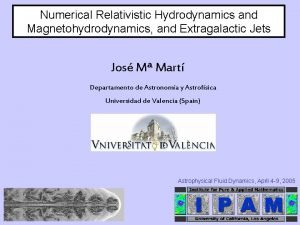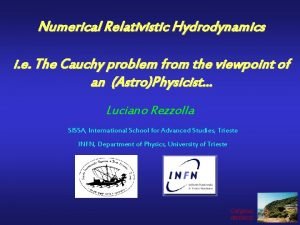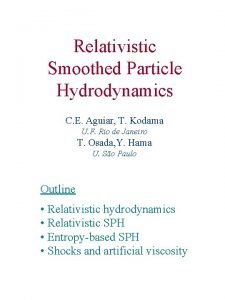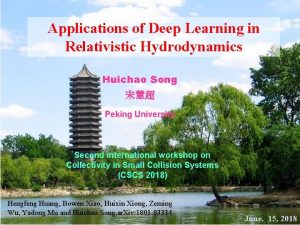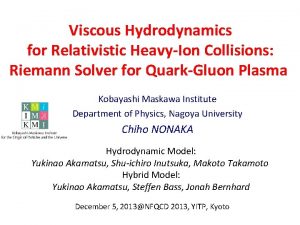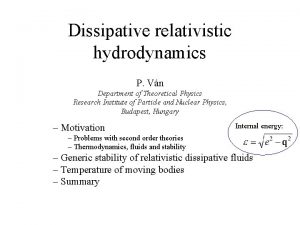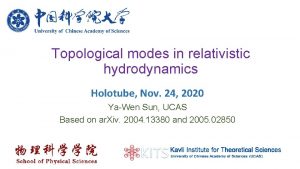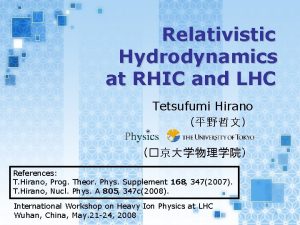Relativistic fluctuating hydrodynamics 2016218 ATHIC 2016 New Delhi
















![Numerical Hydrodynamic Simulation: evolution Evolution conventional 2 nd-order viscous hydro τT ττ x [fm] Numerical Hydrodynamic Simulation: evolution Evolution conventional 2 nd-order viscous hydro τT ττ x [fm]](https://slidetodoc.com/presentation_image/e2b979802ed59b2f587760a8ea7f4708/image-17.jpg)

























- Slides: 42

Relativistic fluctuating hydrodynamics 2016/2/18, ATHIC 2016, New Delhi, India Koichi Murase, The University of Tokyo, Sophia University 2016/2/18 1

Part. X (1/1) Fluctuating hydrodynamics Subject: Thermal fluctuations of fluids Two keywords: • Hydrodynamic fluctuations (HF) = thermal fluctuations of fluid fields • Fluctuating hydrodynamics = dissipative hydrodynamics with hydrodynamic fluctuations as noise terms Hydrodynamic eqs. become Stochastic Partial Differential Equations (SPDEs) like the Langevin equation c. f. L. D. Landau and E. M. Lifshitz, Fluid Mechanics (1959) 2016/2/18 2

Fluctuations in heavy-ion collisions Part. X (1/1) – flow harmonics vn, etc. Response of Matter Eo. S, η, ζ, τR, λ, … • Initial-state fluctuations time • Final observables collision axis 0 – nucleon distribution – quantum fluctuations 2016/2/18 3

Fluctuations in heavy-ion collisions Part. X (1/1) – flow harmonics vn, etc. Other fluctuations + hydro fluctuations + jets/mini-jets + critical phenomena +… • Initial state fluctuation time • Final observables Relativistic hydrodynamics (~QGP) collision axis 0 – nucleon distribution – quantum fluctuations 2016/2/18 4

Hydrodynamics Part. X (1/1) Hydro = Basically, conservation laws e. g. “Hydrodynamics” works iff… fluxes Tij (~ pressure, stress, etc. ) are uniquely determined by conserved densities T 0μ (~e, uμ). Probability e. g. Eo. S & Constitutive eqs. near equilibrium 2016/1/21 ~V-1/2 Pressure thermodynamic limit V ∞ unique! P(e) w/ fixed E/V 5

Part. X (1/1) Hydrodynamic Fluctuations HF: deviation from the equilibrium value e. g. HF ensemble/event averaged Balance thermal fluctuations at each spacetime x FDR Fluctuation-Dissipation Relation decrease anisotropy V: 3+1 dim. volume increase anisotropy HF are important in e-by-e description of HIC 2016/2/18 6

HF in causal dissipative hydrodynamics 2016/2/18 7

Part. X (1/1) Causal hydrodynamics • 1 st-order constitutive equation (Navier-Stokes) + δπμν FDR J. I. Kapusta, et. al. , PRC 85, 054906 (2012) – instability, and acausal modes • 2 nd-order constitutive equation … How is the FDR modified? 2016/2/18 8

Part. X (1/1) Constitutive equation (CE) Constitutive eq. in linear response regime • Integral form: memory function 1 st order term • Differential form: e. g. 1 st order Γ + (higher order terms) finite-order in derivatives 2015/10/26 9

Fluctuation-dissipation relation Part. X (1/1) • Hydro fluctuations appearing in constitutive eq. hydrodynamic fluctuations • Fluctuation-dissipation relation (FDR) G is not delta function in general: “colored noise” 2016/2/18 10

Part. X (1/1) In differential form • Fluctuation in the differential form 1 st order hydro term fluctuation • FDR colored noise ? white/colored? Properties of memory function G(x) 2014/02/04 11

Part. X (1/1) General properties of memory function G A) Retarded G(x) = 0 if t<0 B) Relaxing in a finite time G(x) 0 as t ∞ C) Timelike G(x) = 0 if x 2 <0 D) Positive-semidefinite (from FDR) 〈δΓxδΓx’〉 = TG’xx’: variance-covariance matrix of δΓ 2014/02/04 12

In differential form prob. G(τ) Part. X (1/1) L is expanded to finite order in derivatives τ δΓ retarded: G=0 if t<0 relaxation: G 0 as t ∞ timelike: G=0 if x 2<0 Covariance matrix is positivesemidefinite Fluctuations in the differential form are white 2014/02/04 13

Event-by-event calculations 2016/2/18 14

Part. X (1/1) Setup: Target Collision system Au+Au, √s. NN = 200 Ge. V Au Au Fluctuations • Initial-state fluctuations from nucleon positions • Hydrodynamic fluctuations Comparison between the effects of both fluctuations 2016/2/18 15

Part. X (1/1) Setup: IS Fluctuations and HF • Initial condition Centrality: Minimum bias Model: MC-KLN (CGC) x-y plane ηs-x plane • (3+1)-dim Relativistic Fluctuating Hydrodynamics: Type η/s HF (Gaussian noise) Hydro Cascades Viscous 1/4π none 100 k events 10 M (100 k ☓ 100) Fluctuating 1/4π λ = 1. 0 (fm) 100 k events 10 M (100 k ☓ 100) λ: HF cutoff length scale (Gaussian-smearing width) 2016/2/18 16
![Numerical Hydrodynamic Simulation evolution Evolution conventional 2 ndorder viscous hydro τT ττ x fm Numerical Hydrodynamic Simulation: evolution Evolution conventional 2 nd-order viscous hydro τT ττ x [fm]](https://slidetodoc.com/presentation_image/e2b979802ed59b2f587760a8ea7f4708/image-17.jpg)
Numerical Hydrodynamic Simulation: evolution Evolution conventional 2 nd-order viscous hydro τT ττ x [fm] without HF y [fm] Part. X (1/1) ηs 2 nd-order fluctuating hydro 2016/2/18 x [fm] with HF y [fm] x [fm] ηs 17

Part. X (1/1) vn{EP} vs p. T EP: η-sub, |η| = 1. 0 -2. 8 0 -5% 2016/2/18 • HF increase anisotropies • larger effects in a higher order HF ∝ V-1/2 18

Cutoff scale of HF 2016/2/18 19

Part. X (1/1) Cutoff dependence of “macroscopic” quantities cutoff λ: lower bound of considered HF coarse-graining scale of the system λ-dependence of Eo. S and transport coefficients • e. g. Decomposition of energy density in equilibrium 〈T 00〉 = e internal energy in ordinary sense = 〈eλ〉 + 〈(eλ+Pλ)uλ 2 + πλ 00〉 “internal” energy Global equilibrium in Conventional hydrodynamics 2016/2/18 “kinetic” energy Global equilibrium in Fluctuating hydrodynamics 20

Part. X (1/1) Cutoff dependence of “macroscopic” quantities cutoff λ: lower bound of considered HF coarse-graining scale of the system λ-dependence of Eo. S and transport coefficients • e. g. Decomposition of energy density in equilibrium 〈T 00〉 = e internal energy in ordinary sense = 〈eλ〉 + 〈(eλ+Pλ)uλ 2 + πλ 00〉 “internal” energy “kinetic” energy Every “macroscopic” quantities (eλ, uλ, etc. ) are redefined for each cutoff λ. Macroscopic relations such as viscosity, Eo. S, etc. should be renormalized not to change the global equilibrium properties (Future tasks) 2016/2/18 c. f. P. Kovtun, J. Phys. A: Math. Theor. 45 (2012) 473001 21

Summary 2016/2/18 22

Part. X (1/1) Summary • Hydrodynamic fluctuations (HF) = thermal fluctuations of hydrodynamics • Fluctuating hydrodynamics = dissipative hydrodynamics with HF as noise terms • Properties of HF in causal hydrodynamics: – Colored/white in integral/differential form • Effects on observables from event-by-event simulations HF is Important in extracting the transport properties • Cutoff scale of HF: – Coarse-graining scale is needed in non-linear eqs. – ”Renomalization” of η(λ), Eo. S, f(p, λ), etc. by cutoff λ. 2016/2/18 23

Backup 2014/08/06 24

White noise in the differential form Part. X (1/1) noise term in the differential form fluctuation of dissipative currents ~δ(τ) τ 2 T Re G(ω) ω 2014/02/04 always delta fn. τ 2 T Re G(ω) 〈δΠ(τ)δΠ(0)〉 always exponential -τ/τ (k) r ~e 〈ξ(τ)ξ(0)〉 ξ=LδΠ: white noise δΠ: colored noise ω 25

Part. X (1/1) Integrated Dynamical Model 4. Hadronic cascades (JAM) time 5. Analysis of hadron distribution 3. Particlization at Tsw = 155 Me. V Cooper-Frye formula: f + δf 2. (3+1)-dim. Relativistic Fluctuating Hydrodynamics Eo. S: lattice QCD&HRG, η/s = 1/4π 1. Initial condition MC-KLN 2016/2/18 collision axis 0 Updated version of T. Hirano, P. Huovinen, KM, Y. Nara, PPNP 70, 108 (2012) [ar. Xiv: 1204. 5814] 26

Part. X (1/1) vn{EP} vs p. T EP: η-sub, |η| = 1. 0 -2. 8 20 -30% • Central: (IS Fluct. ) + (HF) • Non-central: (IS Fluct. ) + (HF) + (Collision geometry) 2016/2/18 27

Part. X (1/1) vn{2 m} vs p. T v{2}2 = v 2 + σ 2, v{4}2 , v{6}2 ~ v 2 - σ 2, ~ flow fluct. 20 -30% 2016/2/18 • v{4}2 = v{6}2 > v{2}2 • flow fluctuations σ: larger with HF 28

Part. X (1/1) E-by-E distribution of v 2 v{2}2 = v 2 + σ 2, v{4}2 , v{6}2 ~ v 2 - σ 2, 20 -30% • Broader distribution of v 2 2016/2/18 29

Event-plane fluctuations by HF Part. X (1/1) CMS, ar. Xiv: 1503. 01692 20 -30% J. Jia, and P. Huo, Phys. Rev. C 90, 034905 (2014), • Event-plane decorrelation by HF 2016/2/18 30

Setup A: HF only 2015/7/27 31

Setup A: HF only Part. X (1/1) • Initial condition b = 6. 45 fm (~Centrality 20%) Averaged MC-KLN (CGC) x-y plane ηs-x plane • (3+1)-dim Relativistic Fluctuating Hydrodynamics: Type η/s HF Hydro Cascades Ideal 0 none 1 event 104 events Viscous 1/4π none 1 event 104 events Fluctuating 1/4π σ=0. 8, 1. 0, 1. 2 (fm)* 104 events☓ 3 σ: HF cutoff length scale 2015/7/27 32

Numerical A: Hydrodynamic Simulation: evolution Evolution conventional 2 nd-order viscous hydro τT ττ x [fm] without HF y [fm] Part. X (1/1) ηs 2 nd-order fluctuating hydro 2015/7/22 x [fm] with HF y [fm] x [fm] ηs 33

Part. X (1/1) A: d. Nch/dη • Increase entropy production by HF • Larger effect with a shorter cutoff length σ 2015/7/22 34

Part. X (1/1) A: p. T-spectra (pions) local flows by HF • High-pt particles increase with HF accelerated by local flows 2015/7/22 35

Part. X (1/1) A: Elliptic flow v 2{2} • decreased by viscosity, unchanged by HF local flows do not change the global flow profile 2015/7/22 local flows by HF 36

Part. X (1/1) A: Elliptic flow v 2{2}(η) v 2(p. T) in the last slide v 2 High-p. T particles η • Decrease with viscosity, increase with HF increase of high-p. T particles 2015/7/22 37

Part. X (1/1) B: p. T-spectra (pions) • Points: PHENIX PRC 69 (2004) 034909 • Black lines: ideal hydrodynamics • Blue lines: viscous hydrodynamics • Red lines: fluctuating hydrodynamics 0 -4%, 5 -10%, 10 -15%, 15 -20%, 20 -30%, 30 -40%, 40 -50%, 50 -60%, 60 -70%, 70 -80% from top to bottom (multiplied by 104 -10 -5) • Increase of high-p. T pions: larger in peripheral collisions larger thermal fluctuations in smaller systems • Correction of distribution in Cooper-Frye formula by HF? 2015/7/22 38

Setup B: IS fluctuations + HF 2015/7/27 39

Part. X (1/1) Elliptic flow v 2(η) 0 -5% ηp 10 -15% ηp • v 2(fluctuating) > v 2(ideal) in central collisions Central: (IS Fluct. ) + (HF) Non-central: (IS Fluct. ) + (HF) + (Collision geometry) • Same order with IS fluctuations 2015/9/29 40

v 2{2}(p. T), v 3{2}(p. T) Part. X (1/1) v 2 v 3 • v 2 increase with HF in central collisions • Similar behavior for v 3 2015/9/29 41

Part. X (1/1) v 2{2} vs p. T • Calculations: η/s = 1/4 pi 2015/9/29 42
 Fusiform body shape
Fusiform body shape Hydrodynamics
Hydrodynamics Hydrodynamics
Hydrodynamics Smoothed particle hydrodynamics
Smoothed particle hydrodynamics Frother hydrodynamics
Frother hydrodynamics Teknk
Teknk Hydrodynamics
Hydrodynamics Postcard new delhi answer key
Postcard new delhi answer key Rewla khanpur red light area
Rewla khanpur red light area Relativistic thinking example
Relativistic thinking example Relativistic momentum
Relativistic momentum Doppler effect animation ppt
Doppler effect animation ppt Kinetic energy of a relativistic particle
Kinetic energy of a relativistic particle Relativistic mass
Relativistic mass A physical education chapter 28
A physical education chapter 28 Derivation of relativistic mass
Derivation of relativistic mass Relativistic momentum
Relativistic momentum Relativity
Relativity Bertrand postulate
Bertrand postulate Cognitive development early adulthood
Cognitive development early adulthood Commitment within relativistic thinking
Commitment within relativistic thinking Relativistic circular motion
Relativistic circular motion Relative speed of approach
Relative speed of approach General relativity equation
General relativity equation Relativistic mean field theory
Relativistic mean field theory Relativistic kinetic energy
Relativistic kinetic energy Relativistic thinking example
Relativistic thinking example Relativistic equations of binet
Relativistic equations of binet Al2co32
Al2co32 Fluctuating dipole
Fluctuating dipole Kt1q
Kt1q Fluctuating dipole
Fluctuating dipole Induced dipole
Induced dipole Fluctuating demand marketing
Fluctuating demand marketing Petty cash management
Petty cash management Fluctuating dipole
Fluctuating dipole Fluctuating dipole
Fluctuating dipole Fluctuating loads examples
Fluctuating loads examples Fluctuating dipole
Fluctuating dipole New zealand holiday 2016
New zealand holiday 2016 New zealand health strategy 2016
New zealand health strategy 2016 Delhi house sopot
Delhi house sopot Huzur saran iit delhi
Huzur saran iit delhi

